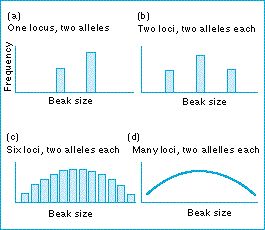Quantitative genetics - Why do some characters have a 'bell curve' distribution?

Why do many characters have a normal distribution?
The reason is as follows. Imagine first that beak size was controlled by a single pair of Mendelian alleles at one locus, with one dominant to the other, AA and Aa long and aa short: in this case, the population would contain two categories of individuals.
Imagine now that it was controlled by two loci with two alleles each. Beak size might now have a background value (say, 1 cm) plus the contribution of the two loci, with an A or a B adding 0.1 cm. If A and B were dominant to a and b , then an aabb individual would have a 1 cm beak, AAbb , Aabb , aaBB , and aaBb 1.1 cm, and AABB , AaBB , AABb , and AaBb 1.2 cm. The figure on the left is the frequency distribution if all alleles had frequency one-half and the two loci were in linkage equilibrium. The distribution now has three categories and has become more spread out.
It becomes still more spread out if it is influenced by six loci and it starts to look normal for 12 loci. Thus, when a large enough number of genes influence a character, it will have a continuous, normal frequency distribution. The normal distribution can result either if there are a large number of alleles at each of a small number of loci influencing the characters, or if there are fewer alleles at a larger number of loci. In this tutorial, we shall mainly discuss the theory of quantitative genetics as if there were many loci, each with a small number of alleles. This may well be the genetic system underlying many continuously varying characters; however, the theory applies equally well when there are a few (even one) loci and many alleles at each.
Figure: In (a) the character is controlled by one locus with two alleles (A and a), where A is dominant to a. There are two discrete phenotypes in the population. (b) The character is controlled by two loci with two alleles each (A and a, B and b). There are three discrete phenotypes. As the number of loci controlling the character increases, the phenotype frequency becomes increasingly continuous.
| Next |



